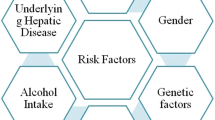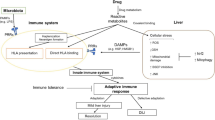Abstract
Sinusoidal obstruction syndrome (SOS) is a liver injury caused by clinical chemotherapy, of which pathogenesis is associated with the damage in liver sinusoidal endothelial cells (LSEC). The unavailability of appropriate specific biomarkers for the early diagnosis of SOS may potentially overlook SOS patients. In this study, we sought to find serum microRNAs (miRNAs) as non-invasive biomarkers for investigating SOS in rats. Male Sprague–Dawley rats were orally administered monocrotaline, and then, their livers and sera were collected after 0.25, 0.5, 1, 2, 4, and 7 days. The rats showed a typical SOS phenotype including LSEC damage as early as day 0.25, followed by severe hepatocyte damage on day 2, and developed hepatic fibrosis from days 4 to 7. The miRNA microarray showed that 65 serum miRNAs were increased in their levels on day 0.25, when LSEC damage was observed, while hepatocyte damage was absent. Among the increased serum miRNAs on days 0.25–1, miR-511-3p was enriched in normal LSECs and miR-21-5p was in both LSECs and hepatocytes, suggesting that they were released into blood from the damaged LSECs. The miR-122-5p, miR-192-5p, and miR-101b-3p, which were enriched in hepatocytes, reached the highest levels in serum on day 2, suggesting their utility as indicators for hepatocyte damage. No miRNA showing an increasing trend from days 4 to 7 was found as a biomarker for fibrosis. In conclusion, we found that LSEC-derived miR-21-5p and especially miR-511-3p in serum would serve as early phase biomarkers for SOS in response to LSEC damage.








Similar content being viewed by others
Abbreviations
- ALT:
-
Alanine aminotransferase
- AST:
-
Aspartate aminotransferase
- Ath:
-
Arabidopsis thaliana
- AZAN:
-
Azocarmine and aniline blue
- H&E:
-
Hematoxylin and eosin
- LSEC:
-
Liver sinusoidal endothelial cell
- MCT:
-
Monocrotaline
- miRNA:
-
MicroRNA
- NPC:
-
Non-parenchymal cell
- SEM:
-
Standard error of the mean
- snRNA:
-
Small nuclear RNA
- SOS:
-
Sinusoidal obstruction syndrome
- T-Bil:
-
Total bilirubin
- TSI:
-
Tissue specificity index
References
Ameres SL, Zamore PD (2013) Diversifying microRNA sequence and function. Nat Rev Mol Cell Biol 14(8):475–488. https://doi.org/10.1038/nrm3611
Arroyo JD, Chevillet JR, Kroh EM et al (2011) Argonaute2 complexes carry a population of circulating microRNAs independent of vesicles in human plasma. Proc Natl Acad Sci USA 108(12):5003–5008. https://doi.org/10.1073/pnas.1019055108
Bala S, Petrasek J, Mundkur S et al (2012) Circulating microRNAs in exosomes indicate hepatocyte injury and inflammation in alcoholic, drug-induced, and inflammatory liver diseases. Hepatology 56(5):1946–1957. https://doi.org/10.1002/hep.25873
Bandiera S, Pfeffer S, Baumert TF, Zeisel MB (2015) miR-122—a key factor and therapeutic target in liver disease. J Hepatol 62(2):448–457. https://doi.org/10.1016/j.jhep.2014.10.004
Carreras E, Bertz H, Arcese W et al (1998) Incidence and outcome of hepatic veno-occlusive disease after blood or marrow transplantation: a prospective cohort study of the European Group for Blood and Marrow Transplantation. European Group for Blood and Marrow Transplantation Chronic Leukemia Working Party. Blood 92(10):3599–3604
Chang J, Nicolas E, Marks D et al (2004) miR-122, a mammalian liver-specific microRNA, is processed from hcr mRNA and may downregulate the high affinity cationic amino acid transporter CAT-1. RNA Biol 1(2):106–113
Coppell JA, Richardson PG, Soiffer R et al (2010) Hepatic veno-occlusive disease following stem cell transplantation: incidence, clinical course, and outcome. Biol Blood Marrow Transplant 16(2):157–168. https://doi.org/10.1016/j.bbmt.2009.08.024
de Rie D, Abugessaisa I, Alam T et al (2017) An integrated expression atlas of miRNAs and their promoters in human and mouse. Nat Biotechnol 35(9):872–878. https://doi.org/10.1038/nbt.3947
DeLeve LD (2007) Hepatic microvasculature in liver injury. Semin Liver Dis 27(4):390–400. https://doi.org/10.1055/s-2007-991515
DeLeve LD, McCuskey RS, Wang X et al (1999) Characterization of a reproducible rat model of hepatic veno-occlusive disease. Hepatology 29(6):1779–1791. https://doi.org/10.1002/hep.510290615
DeLeve LD, Shulman HM, McDonald GB (2002) Toxic injury to hepatic sinusoids: sinusoidal obstruction syndrome (veno-occlusive disease). Semin Liver Dis 22(1):27–42. https://doi.org/10.1055/s-2002-23204
Gerlach CV, Vaidya VS (2017) MicroRNAs in injury and repair. Arch Toxicol 91(8):2781–2797. https://doi.org/10.1007/s00204-017-1974-1
Gomez-Arroyo JG, Farkas L, Alhussaini AA et al (2012) The monocrotaline model of pulmonary hypertension in perspective. Am J Physiol Lung Cell Mol Physiol 302(4):363–369. https://doi.org/10.1152/ajplung.00212.2011
Gubrij IB, Pangle AK, Pang L, Johnson LG (2016) Reversal of microRNA dysregulation in an animal model of pulmonary hypertension. PLoS One 11(1):e0147827. https://doi.org/10.1371/journal.pone.0147827
Hanke M, Hoefig K, Merz H et al (2010) A robust methodology to study urine microRNA as tumor marker: microRNA-126 and microRNA-182 are related to urinary bladder cancer. Urol Oncol 28(6):655–661. https://doi.org/10.1016/j.urolonc.2009.01.027
Hunter MP, Ismail N, Zhang X et al (2008) Detection of microRNA expression in human peripheral blood microvesicles. PLoS One 3(11):e3694. https://doi.org/10.1371/journal.pone.0003694
Ikezoe T, Togitani K, Komatsu N, Isaka M, Yokoyama A (2010) Successful treatment of sinusoidal obstructive syndrome after hematopoietic stem cell transplantation with recombinant human soluble thrombomodulin. Bone Marrow Transplant 45(4):783–785. https://doi.org/10.1038/bmt.2009.217
Jenkins RH, Martin J, Phillips AO, Bowen T, Fraser DJ (2012) Transforming growth factor beta1 represses proximal tubular cell microRNA-192 expression through decreased hepatocyte nuclear factor DNA binding. Biochem J 443(2):407–416. https://doi.org/10.1042/BJ20111861
Johnson SM, Grosshans H, Shingara J et al (2005) RAS is regulated by the let-7 microRNA family. Cell 120(5):635–647. https://doi.org/10.1016/j.cell.2005.01.014
Jones RJ, Lee KS, Beschorner WE et al (1987) Venoocclusive disease of the liver following bone marrow transplantation. Transplantation 44(6):778–783
Krauskopf J, Caiment F, Claessen SM et al (2015) Application of high-throughput sequencing to circulating microRNAs reveals novel biomarkers for drug-induced liver injury. Toxicol Sci 143(2):268–276. https://doi.org/10.1093/toxsci/kfu232
Lawrie CH, Gal S, Dunlop HM et al (2008) Detection of elevated levels of tumour-associated microRNAs in serum of patients with diffuse large B-cell lymphoma. Br J Haematol 141(5):672–675. https://doi.org/10.1111/j.1365-2141.2008.07077.x
Liang Y, Ridzon D, Wong L, Chen C (2007) Characterization of microRNA expression profiles in normal human tissues. BMC Genom 8:166. https://doi.org/10.1186/1471-2164-8-166
Ludwig N, Leidinger P, Becker K et al (2016) Distribution of miRNA expression across human tissues. Nucleic Acids Res 44(8):3865–3877. https://doi.org/10.1093/nar/gkw116
McDonald GB, Sharma P, Matthews DE, Shulman HM, Thomas ED (1984) Venocclusive disease of the liver after bone marrow transplantation: diagnosis, incidence, and predisposing factors. Hepatology 4(1):116–122. https://doi.org/10.1002/hep.1840040121
McDonald GB, Hinds MS, Fisher LD et al (1993) Veno-occlusive disease of the liver and multiorgan failure after bone marrow transplantation: a cohort study of 355 patients. Ann Intern Med 118(4):255–267. https://doi.org/10.7326/0003-4819-118-4-199302150-00003
Minami K, Uehara T, Morikawa Y et al (2014) miRNA expression atlas in male rat. Sci Data 1:140005. https://doi.org/10.1038/sdata.2014.5
Mohty M, Malard F, Abecassis M et al (2016) Revised diagnosis and severity criteria for sinusoidal obstruction syndrome/veno-occlusive disease in adult patients: a new classification from the European Society for Blood and Marrow Transplantation. Bone Marrow Transplant 51(7):906–912. https://doi.org/10.1038/bmt.2016.130
Oda S, Takeuchi M, Akai S, Shirai Y, Tsuneyama K, Yokoi T (2018) miRNA in rat liver sinusoidal endothelial cells and hepatocytes and application to circulating biomarkers that discern pathogenesis of liver injuries. Am J Pathol 188(4):916–928. https://doi.org/10.1016/j.ajpath.2017.12.007
Pavkovic M, Robinson-Cohen C, Chua AS et al (2016) Detection of drug-induced acute kidney injury in humans using urinary KIM-1, miR-21, -200c, and -423. Toxicol Sci 152(1):205–213. https://doi.org/10.1093/toxsci/kfw077
Qu K, Zhang X, Lin T et al (2017) Circulating miRNA-21-5p as a diagnostic biomarker for pancreatic cancer: evidence from comprehensive miRNA expression profiling analysis and clinical validation. Sci Rep 7(1):1692. https://doi.org/10.1038/s41598-017-01904-z
Richardson PG, Riches ML, Kernan NA et al (2016) Phase 3 trial of defibrotide for the treatment of severe veno-occlusive disease and multi-organ failure. Blood 127(13):1656–1665. https://doi.org/10.1182/blood-2015-10-676924
Robinson SM, Mann J, Vasilaki A et al (2013) Pathogenesis of FOLFOX induced sinusoidal obstruction syndrome in a murine chemotherapy model. J Hepatol 59(2):318–326. https://doi.org/10.1016/j.jhep.2013.04.014
Saikumar J, Hoffmann D, Kim TM et al (2012) Expression, circulation, and excretion profile of microRNA-21, -155, and -18a following acute kidney injury. Toxicol Sci 129(2):256–267. https://doi.org/10.1093/toxsci/kfs210
Saikumar J, Ramachandran K, Vaidya VS (2014) Noninvasive micromarkers. Clin Chem 60(9):1158–1173. https://doi.org/10.1373/clinchem.2013.216044
Seike M, Goto A, Okano T et al (2009) MiR-21 is an EGFR-regulated anti-apoptotic factor in lung cancer in never-smokers. Proc Natl Acad Sci USA 106(29):12085–12090. https://doi.org/10.1073/pnas.0905234106
Squadrito ML, Pucci F, Magri L et al (2012) miR-511-3p modulates genetic programs of tumor-associated macrophages. Cell Rep 1(2):141–154. https://doi.org/10.1016/j.celrep.2011.12.005
Takeuchi-Yorimoto A, Yamaura Y, Kanki M et al (2016) MicroRNA-21 is associated with fibrosis in a rat model of nonalcoholic steatohepatitis and serves as a plasma biomarker for fibrotic liver disease. Toxicol Lett 258:159–167. https://doi.org/10.1016/j.toxlet.2016.06.012
Tokairin T, Nishikawa Y, Doi Y et al (2002) A highly specific isolation of rat sinusoidal endothelial cells by the immunomagnetic bead method using SE-1 monoclonal antibody. J Hepatol 36(6):725–733. https://doi.org/10.1016/S0168-8278(02)00048-X
Uematsu Y, Akai S, Tochitani T, Oda S, Yamada T, Yokoi T (2016) MicroRNA-mediated Th2 bias in methimazole-induced acute liver injury in mice. Toxicol Appl Pharmacol 307:1–9. https://doi.org/10.1016/j.taap.2016.07.008
Valadi H, Ekstrom K, Bossios A, Sjostrand M, Lee JJ, Lotvall JO (2007) Exosome-mediated transfer of mRNAs and microRNAs is a novel mechanism of genetic exchange between cells. Nat Cell Biol 9(6):654–659. https://doi.org/10.1038/ncb1596
Vickers KC, Palmisano BT, Shoucri BM, Shamburek RD, Remaley AT (2011) MicroRNAs are transported in plasma and delivered to recipient cells by high-density lipoproteins. Nat Cell Biol 13(4):423–433. https://doi.org/10.1038/ncb2210
Wang K, Zhang S, Marzolf B et al (2009) Circulating microRNAs, potential biomarkers for drug-induced liver injury. Proc Natl Acad Sci USA 106(11):4402–4407. https://doi.org/10.1073/pnas.0813371106
Xie G, Wang L, Wang X, Wang L, DeLeve LD (2010) Isolation of periportal, midlobular, and centrilobular rat liver sinusoidal endothelial cells enables study of zonated drug toxicity. Am J Physiol Gastrointest Liver Physiol 299(5):G1204–G1210. https://doi.org/10.1152/ajpgi.00302.2010
Xu J, Wu C, Che X et al (2011) Circulating microRNAs, miR-21, miR-122, and miR-223, in patients with hepatocellular carcinoma or chronic hepatitis. Mol Carcinog 50(2):136–142. https://doi.org/10.1002/mc.20712
Yakushijin K, Atsuta Y, Doki N et al (2016) Sinusoidal obstruction syndrome after allogeneic hematopoietic stem cell transplantation: Incidence, risk factors and outcomes. Bone Marrow Transplant 51(3):403–409. https://doi.org/10.1038/bmt.2015.283
Yamaura Y, Nakajima M, Takagi S, Fukami T, Tsuneyama K, Yokoi T (2012) Plasma microRNA profiles in rat models of hepatocellular injury, cholestasis, and steatosis. PLoS One 7(2):e30250. https://doi.org/10.1371/journal.pone.0030250
Yanai I, Benjamin H, Shmoish M et al (2005) Genome-wide midrange transcription profiles reveal expression level relationships in human tissue specification. Bioinformatics 21(5):650–659. https://doi.org/10.1093/bioinformatics/bti042
Zernecke A, Bidzhekov K, Noels H et al (2009) Delivery of microRNA-126 by apoptotic bodies induces CXCL12-dependent vascular protection. Sci Signal 2(100):ra81. https://doi.org/10.1126/scisignal.2000610
Acknowledgements
The authors wish to thank Kaori Ushida, Yuko Mizuno, Miwa Itoh, and Eri Yorifuji from the Division for Medical Research Engineering, Nagoya University Graduate School of Medicine for their technical advice regarding the histological examinations.
Funding
This study was supported by a Grant from the Research Foundation for Pharmaceutical Sciences and by a Grants-in-Aid for Scientific Research (A) (16H02616) from the Japan Society for the Promotion of Science.
Author information
Authors and Affiliations
Corresponding author
Ethics declarations
Ethical approval
All animal experiments were carried out in accordance with the guidelines established by the Institute for Laboratory Animal Research of the Medical School of Nagoya University, Japan.
Conflict of interest
The authors declare that they have no conflict of interest.
Electronic supplementary material
Below is the link to the electronic supplementary material.
Rights and permissions
About this article
Cite this article
Takeuchi, M., Oda, S., Tsuneyama, K. et al. Comprehensive analysis of serum microRNAs in hepatic sinusoidal obstruction syndrome (SOS) in rats: implication as early phase biomarkers for SOS. Arch Toxicol 92, 2947–2962 (2018). https://doi.org/10.1007/s00204-018-2269-x
Received:
Accepted:
Published:
Issue Date:
DOI: https://doi.org/10.1007/s00204-018-2269-x




